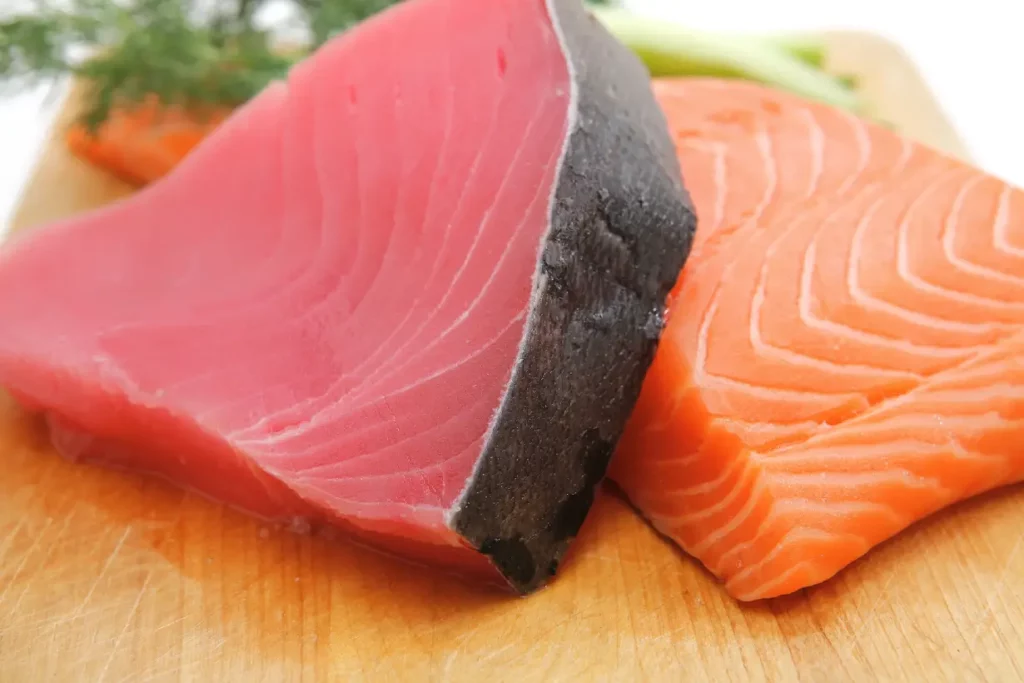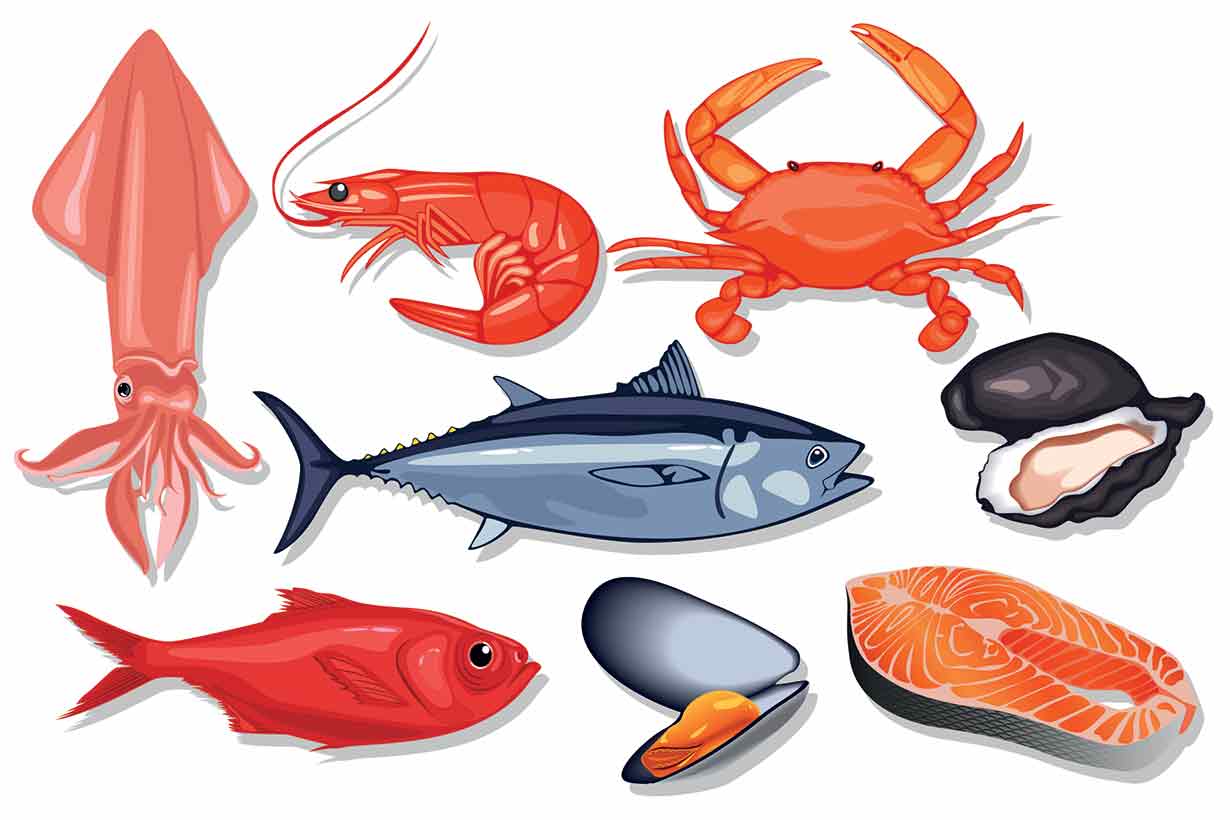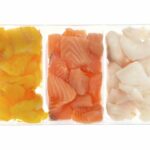Salmon and tuna are two of the most popular varieties of fish, and this article provides a complete nutritional comparison of the two.
This comparison explores the respective calorie, macronutrient, omega-3, vitamin, and mineral content of salmon and tuna.
We’ll also examine key considerations, such as the respective mercury levels of each fish.
Table of contents
The Most Popular Varieties of Salmon and Tuna

Before we begin the comparison, it is worth noting that there are many different varieties of salmon and tuna, each with slightly different nutritional profiles.
For the purpose of this article, we will compare both fresh and canned tuna and salmon products. These comparisons will be based on the most popular varieties of each, as listed below:
- Fresh salmon: Atlantic salmon (farmed)
- Fresh tuna: Yellowfin tuna
- Canned salmon: Pink salmon
- Canned tuna: Albacore tuna
While salmon and tuna are commonly thought of as oily fish, is this strictly true? And does one offer more nutritional benefits than the other?
Fresh Salmon vs. Tuna: Nutritional Comparison
First, let’s compare the nutritional properties of fresh salmon and tuna.
Nutritional data has been sourced from the USDA’s FoodData Central database, based on the nutritional composition per 100 grams of raw weight (1, 2).
Percent daily values (% DV) have been calculated based on the FDA’s recommended daily values (3).
Calories and Macronutrients
| Nutrient | Atlantic salmon | Yellowfin tuna |
|---|---|---|
| Calories | 208 kcal | 109 kcal |
| Carbohydrate | 0 g | 0 g |
| Fiber | 0 g | 0 g |
| Sugars | 0 g | 0 g |
| Fat | 13.4 g, 17% DV | 0.49 g, 1% DV |
| Saturated fat | 3.05 g, 15% DV | 0.17 g, 1% DV |
| Monounsaturated fat | 3.77 g | 0.12 g |
| Polyunsaturated fat | 3.89 g | 0.15 g |
| Omega-3 | 2.51 g | 0.11 g |
| Omega-6 | 0.98 g | 0.02 g |
| Protein | 20.4 g, 41% DV | 24.4 g, 49% DV |
| Cholesterol | 55 mg, 18% DV | 39 mg, 13% DV |
As the table indicates, farmed Atlantic salmon contains nearly double the calories of yellowfin tuna. This is due to its significantly higher fat content.
With over 2.5 grams of omega-3, farmed Atlantic salmon offers substantially more omega-3 than yellowfin tuna.
Since yellowfin tuna is the leaner fish, it contains approximately four more grams of protein than Atlantic salmon, with a protein content of 24.4 grams.
Looking for Fresh Tuna with a Higher Omega-3 Content?
While yellowfin tuna is probably the most popular variety of fresh tuna, it is worth noting that a different species–bluefin–has a significantly higher fat content.
Per 100 grams of raw weight, bluefin tuna provides 1.3 grams of omega-3 fatty acids (4).
However, bluefin tuna is not as widely available and comes with a higher price tag.
Vitamins
| Nutrient | Atlantic salmon | Yellowfin tuna |
|---|---|---|
| Choline | 78.5 mg, 14% DV | 65 mg, 12% DV |
| Folate, DFE | 26 mcg, 7% DV | 2 mcg, 1% DV |
| Thiamin (B1) | 0.21 mg, 18% DV | 0.12 mg, 10% DV |
| Riboflavin (B2) | 0.16 mg, 12% DV | 0.12 mg, 9% DV |
| Niacin (B3) | 8.67 mg, 54% DV | 18.5 mg, 116% DV |
| Pantothenic acid (B5) | 1.55 mg, 31% DV | 0.28 mg, 6% DV |
| Vitamin B6 | 0.64 mg, 38% DV | 0.93 mg, 55% DV |
| Vitamin B12 | 3.23 mcg, 135% DV | 2.08 mcg, 87% DV |
| Vitamin A, RAE | 58 mcg, 6% DV | 18 mcg, 2% DV |
| Vitamin C | 3.9 mg, 4% DV | 0 mg, 0% DV |
| Vitamin D | 11 mcg, 55% DV | 1.7 mcg, 9% DV |
| Vitamin E | 3.55 mg, 24% DV | 0.24 mg, 2% DV |
| Vitamin K | 0.5 mcg, <1% DV | 0.1 mcg, <1% DV |
As we can see in the table, both Atlantic salmon and yellowfin tuna provide a range of essential vitamins. Both fish are rich in B vitamins, while salmon is a particularly good source of fat-soluble vitamins D and E.
Minerals
| Mineral | Atlantic salmon | Yellowfin tuna |
|---|---|---|
| Calcium | 9 mg, <1% DV | 4 mg, <1% DV |
| Copper | 0.05 mg, 6% DV | 0.04 mg, 4% DV |
| Iron | 0.34 mg, 2% DV | 0.77 mg, 4% DV |
| Magnesium | 27 mg, 6% DV | 35 mg, 8% DV |
| Manganese | 0.01 mg, <1% DV | 0.01 mg, <1% DV |
| Phosphorus | 240 mg, 19% DV | 278 mg, 22% DV |
| Potassium | 363 mg, 8% DV | 441 mg, 9% DV |
| Selenium | 24 mcg, 44% DV | 91 mcg, 165% DV |
| Sodium | 59 mg, 3% DV | 45 mg, 2% DV |
| Zinc | 0.36 mg, 3% DV | 0.37 mg, 3% DV |
Like most seafood, Atlantic salmon and yellowfin tuna both provide high amounts of selenium. They also contain a similar range of minerals in low to moderate concentrations.
Mercury Content
The FDA’s monitoring program of mercury concentrations in fish from 1990–2012 found that (5):
- Fresh salmon had a mean mercury concentration of 0.022 PPM, based on 94 samples. However, this included various species of salmon rather than solely Atlantic salmon.
- Yellowfin tuna had a mean mercury concentration of 0.354 PPM, based on 231 samples.
Based on this data, it’s likely that yellowfin tuna contains more than ten times the mercury content of Atlantic salmon.
According to a joint advisory published by the FDA and EPA, salmon is classified as a “best choice” based on its mercury content, whereas yellowfin tuna is considered a “good choice” (6).
The advisory recommends that pregnant and breastfeeding women consume 2-3 servings of fish from the “best choice” list or 1 serving from the “good choice” list each week.
For children, the advisory recommends 2 servings per week, only from the “best choices” list. The appropriate serving size depends on the child’s age.
More information is available here: FDA & EPA: Advice about Eating Fish
Summary
In summary, fresh Atlantic salmon and yellowfin tuna are both nutritious options that provide a good range of essential nutrients.
If prioritizing higher protein with fewer calories, then yellowfin tuna is the more favorable choice.
However, for those looking to increase their omega-3 intake, Atlantic salmon is the better choice.
It is also worth noting that yellowfin tuna has significantly higher mercury concentrations, meaning it should not be consumed as freqently as Atlantic salmon.
Canned Salmon vs. Tuna: Nutritional Comparison
We’ll now compare the nutritional profiles of canned pink salmon and canned albacore tuna, also known as “white tuna.”
How do these popular canned fish products differ?
Once again, nutritional data is sourced from the USDA database. To ensure a like-for-like comparison, the listed nutritional values are per 100 grams, canned in water, drained solids (7, 8).
Calories and Macronutrients
| Nutrient | Canned pink salmon | Canned albacore tuna |
|---|---|---|
| Calories | 136 kcal | 128 kcal |
| Carbohydrate | 0 g | 0 g |
| Fiber | 0 g | 0 g |
| Sugars | 0 g | 0 g |
| Fat | 4.21 g, 5% DV | 2.97 g, 4% DV |
| Saturated fat | 0.75 g, 4% DV | 0.79 g, 4% DV |
| Monounsaturated fat | 0.97 g | 0.78 g |
| Polyunsaturated fat | 1.3 g | 1.11 g |
| Omega-3 | 1.07 g | 0.95 g |
| Omega-6 | 0.08 g | 0.06 g |
| Protein | 24.6 g, 49% DV | 23.6 g, 47% DV |
| Cholesterol | 83 mg, 28% DV | 42 mg, 14% DV |
The first thing you may notice is that canned pink salmon and albacore tuna are much more similar nutritionally compared to fresh Atlantic salmon and yellowfin tuna.
Canned pink salmon and albacore tuna contain a similar number of calories and are very closely matched in protein and omega-3 content.
Vitamins
| Vitamin | Canned pink salmon | Canned albacore tuna |
|---|---|---|
| Choline | 88 mg, 16% DV | 29.3 mg, 5% DV |
| Folate, DFE | 4 mcg, 1% DV | 2 mcg, <1% DV |
| Thiamin (B1) | 0.03 mg, 3% DV | 0.01 mg, <1% DV |
| Riboflavin (B2) | 0.20 mg, 15% DV | 0.04 mg, 3% DV |
| Niacin (B3) | 7.43 mg, 46% DV | 5.8 mg, 36% DV |
| Pantothenic acid (B5) | – | 0.12 mg, 2% DV |
| Vitamin B6 | 0.11 mg, 6% DV | 0.22 mg, 13% DV |
| Vitamin B12 | 4.96 mcg, 207% DV | 1.17 mcg, 49% DV |
| Vitamin A, RAE | 20 mcg, 2% DV | 6 mcg, <1% DV |
| Vitamin C | 0 mg, 0% DV | 0 mg, 0% DV |
| Vitamin D | 14.1 mcg, 71% DV | 2 mcg, 10% DV |
| Vitamin E | 1.28 mg, 9% DV | 0.85 mg, 6% DV |
| Vitamin K | 0.1 mcg, <1% DV | 2.5 mcg, 2% DV |
Both canned pink salmon and albacore tuna provide significant amounts of niacin and vitamin B12. Pink salmon is also one of the best fish sources of vitamin D.
Minerals
| Mineral | Canned pink salmon | Canned albacore tuna |
|---|---|---|
| Calcium | 60 mg, 5% DV | 14 mg, 1% DV |
| Copper | 0.08 mg, 9% DV | 0.04 mg, 4% DV |
| Iron | 0.57 mg, 3% DV | 0.97 mg, 5% DV |
| Magnesium | 24 mg, 6% DV | 33 mg, 8% DV |
| Manganese | 0.01 mg, <1% DV | 0.02 mg, <1% DV |
| Phosphorus | 253 mg, 20% DV | 217 mg, 17% DV |
| Potassium | 326 mg, 7% DV | 237 mg, 5% DV |
| Selenium | 40 mcg, 73% DV | 66 mcg, 120% DV |
| Sodium | 378 mg, 16% DV | 377 mg, 16% DV |
| Zinc | 0.65 mg, 6% DV | 0.48 mg, 4% DV |
Canned pink salmon and albacore tuna have a similar mineral composition, with both options being excellent sources of selenium.
Mercury Content
The FDA’s Monitoring program found the following mean mercury concentrations in canned salmon and albacore tuna (5):
- Canned salmon: 0.014 PPM, based on 19 samples
- Canned albacore tuna: 0.350 PPM, based on 451 samples
The canned salmon samples did not only include pink salmon, but all salmon species tend to be low in mercury, so we can be relatively confident in this mercury concentration.
Like fresh yellowfin tuna, canned albacore is also relatively high in mercury. The joint FDA and EPA advisory classifies pink salmon as a “best choice,” while canned albacore tuna is a “good choice” (6).
Once again, for more information on this advisory, you can see the resource here: FDA & EPA: Advice about Eating Fish
Summary
As mentioned earlier, the nutritional differences between canned pink salmon and canned albacore tuna are modest.
Both are relatively low in calories, high in protein, and provide a good amount of omega-3 fatty acids.
However, once again, canned tuna contains significantly more mercury than canned salmon.
Aside from mercury considerations, other factors like price and personal preference may be more significant than the nutritional differences between these two canned fish options.
For further information on salmon, tuna, and canned fish varieties, here are some related resources:
15 Types of Canned Fish With Nutrition Facts + Mercury Content








